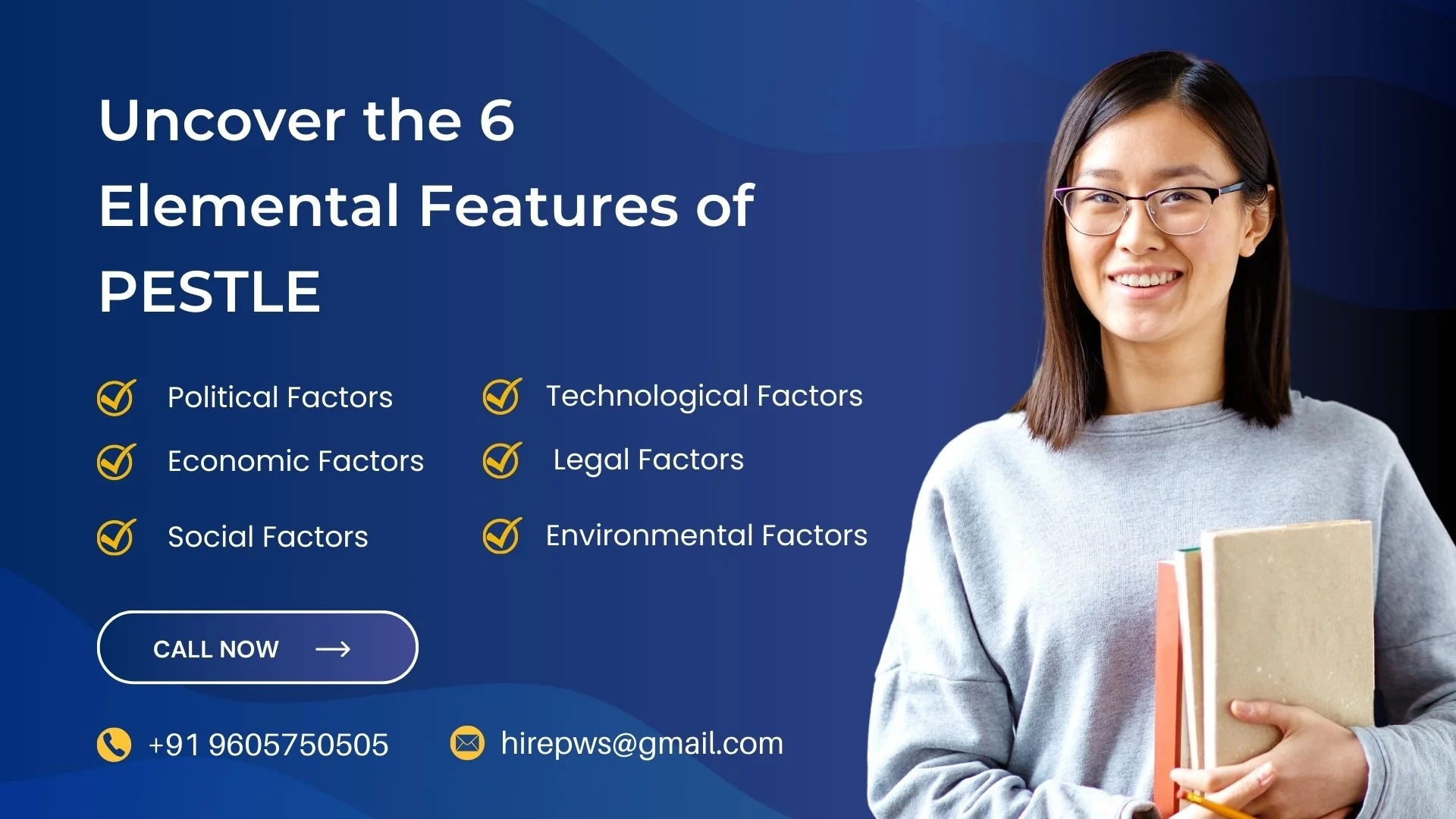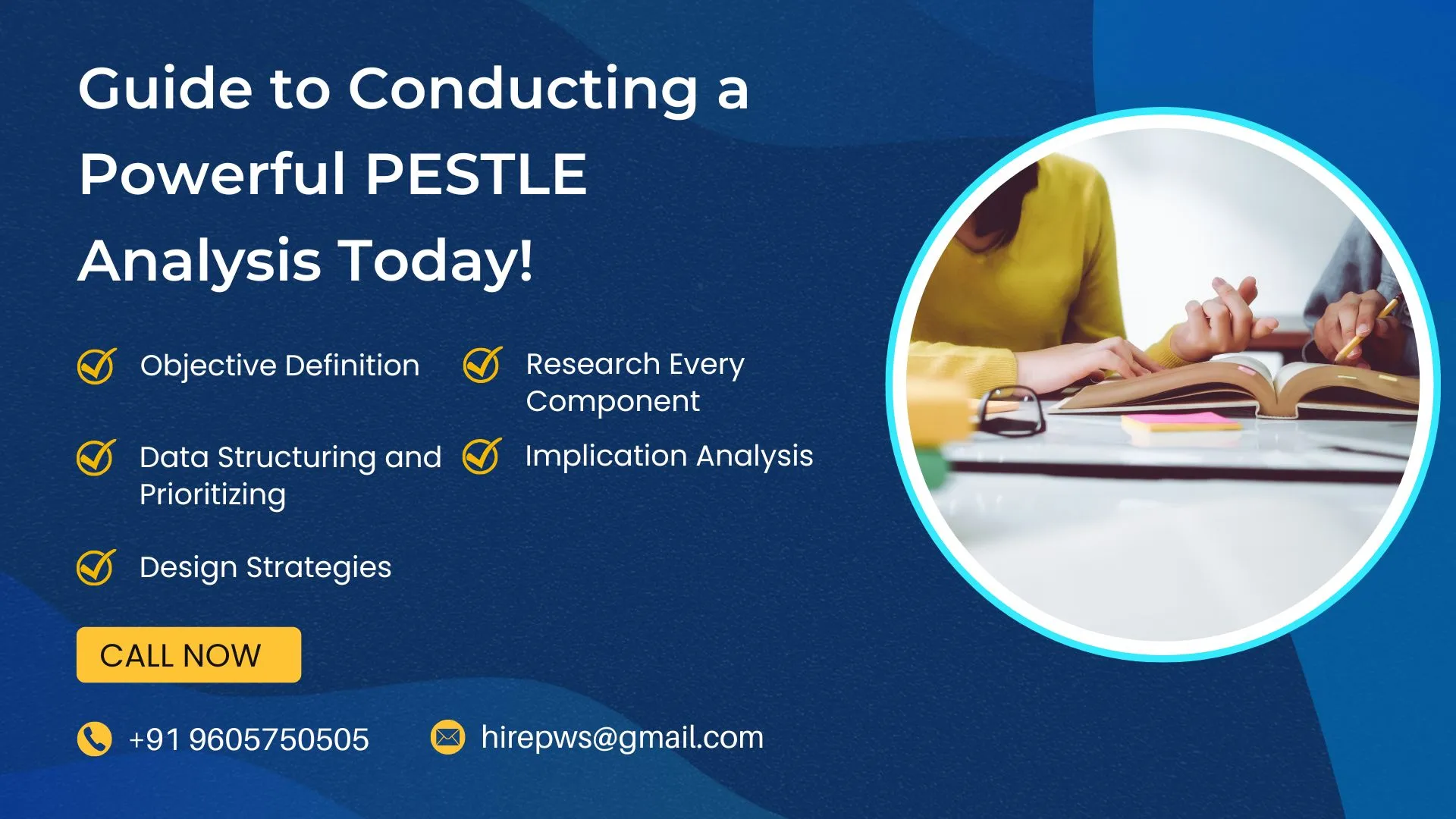Learn the Finer Points of How to Write a PESTLE Analysis
- Sugathan
- December 23, 2024
Have you ever thought about how organizations cope with the pressures? The following post informs how to write a PESTLE analysis. At the same time, a structured outline is made that can be used in checking up on the technical, legal, social, political, and environmental factors. From this, you will emerge with the practical know-how for an enhanced PESTLE analysis of supporting effective strategic thinking and planning.
What is PESTLE analysis?
PESTLE analysis is a powerful strategy tool derived from the considerations of the following factors, namely, political, economic, social, technological, legal, and environmental, which allows companies to understand outside forces and form the basis of wise decisions to ensure long-term success.
What Forms the 6 Elemental Features of PESTLE?
One of the critical steps while writing a PEST analysis and preparing a thorough PEST analysis report is understanding the six elements of PESTLE analysis. Evaluating any outside effect assists organizations to make decisions and adapt themselves to changing conditions for each one of these six elements. Now, let’s discuss these crucial components:

Political Factors
This dimension requires one to study the tax laws, trade tariffs, and stability of politics and policies regulating the government. Political factors do affect the operations of businesses; this includes market conditions, entry barriers, and strategic long-term planning. In general, economic growth tends to be spurred by political stability. Political risk arises due to a setting that is politically unstable.
Economic Factors
This is encompassed within employment trends, GDP growth rate, interest rates, inflationary rate, and currency rates, among other factors. These features impact directly on consumer purchasing power, pricing policies, as well as the general profitability of the company.
Social Factors
These involve changes in lifestyle, cultural views, demographics, and consumer behavior. These point to the way in which changes in the product, branding, and demand mirror the changes in the society. For example, consumers buying more “ecofriendly” products and gaining increased ecological consciousness might convince businesses to turn green.
Technological Factors
They consist of automation, innovation trends, and technological advancement. Forming the competitive environment by developing products and boosting operational effectiveness It can give a significant advantage against change in technology if it remains ahead of it in the case of modern markets.
Legal Factors
Our team of intellectual PESTLE analysts is competent in the understanding of relevant compliance requirements and industry regulations, which would allow your business to oversee the required legal considerations for an optimum analysis.
Environmental Factors
Numerous environmental factors, like climate change as well as environmental impacts, play a huge role in determining the environmental footprint of the business and ensuring that it falls under the required criteria for keeping the planet safe.
Detailed Guide Into Doing a PESTLE Analysis
Learn to write a PESTLE analysis with this simple guide. With this step-by-step process, you will evaluate external factors influencing your business and develop a suitable strategy.

Objective Definition
Define the objective of your PESTLE analysis. Whether you want to find market opportunities or analyze risk, an objective defines what you are going to achieve in your research and analysis.
Research Every Component
Gather data concerning each PESTLE element: Political, Economic, Social, Technological, Legal, and Environmental. Our writers make sure to gather the required reports and conduct detailed research to ensure that their expert opinion holds significant credibility.
Data Structuring and Prioritizing
Once all the data is gathered, our analysts then dive into the process of categorizing and structuring the same with an intention of deriving the factors that significantly impact the goals of the organization.
Implication Analysis
Analyze the implications of each of these elements in your business environment. Give an example of how these political shifts affect regulations of your business. Which one of the technological developments can change your sector or industry? The more familiar you become with each of their respective consequences, the more it will help you to overcome such obstacles and take advantage of opportunities.
Design Strategies:
As a result of your exploration, you now have enough information to develop targeted strategies. For example, should your market be sensitive to recession, you may seek to expand your product line or reduce spending in a manner to reduce its risk.
What is the Essential Purpose of PESTLE Analysis
This helps organizations assess external factors that relate to political, economic, social, technological, legal, and environmental forces. Through the understanding of the process of writing a great PESTLE analysis, businesses find more opportunities and can reduce any existing or potential risks and thus decide whether an undertaking should be pursued or not with a competitive edge to drive sustainable growth.
Perks of a PESTLE Analysis
Any business can have an advantage by knowing how to write a PESTLE study since it will enhance awareness of external factors that may affect operations. Hence, PESTLE helps businesses gain a competitive edge by allowing them to make informed decisions, discover opportunities, and reduce risks for sustainable success. The key benefits are:
- Helps organizations make data-driven decisions based on external factors.
- Recognizes potential threats before they have an impact on operations.
- Draws one's attention to new market trends and opportunities.
- It channels long-term planning and strategy by understanding external dynamics.
- With the help of technology, businesses can adapt to changes in the business environment.
- It provides information that gives a business an edge against its competitors.
Drawbacks of PESTLE Analysis
When learning how to do a PESTLE analysis assignment, one has to know the downsides. Even though PESTLE analysis is rich with information, it comes along with some disadvantages that reduce its usage in business strategy and assignments. Here are some of the most significant disadvantages:

- Taking a lot of time in collecting and analyzing data for each element
- The number of factors analyzed may be too many and complicated to understand.
- Focus on external factors may overlook internal business issues or capabilities.
- PESTLE cannot always predict sudden shifts in factors, such as political upheaval or technological breakthroughs.
- Interpretation of data may be subjective, leading to biased or inconsistent conclusions.
- Requires significant resources in terms of research, expertise, and data collection.
PESTLE or SWOT Analysis: Which One is Better?
Both PESTLE and SWOT analyses have different insights, but when both are applied together, it gives a more comprehensive view of a business environment. Here’s how to apply both of them properly:
-
Purpose:
PESTLE analysis deals with the external factors affecting a business, whereas SWOT deals with the internal factors (Strengths, Weaknesses) and the external factors (Opportunities, Threats). -
Scope:
The PESTLE is considered for analyzing the macro-environmental influences, whereas a SWOT analyzes a more comprehensive extent of business elements, including a firm's strengths and weaknesses. -
Application:
An example of an application of PESTLE can be given as identifying external trends and risks, whereas for SWOT, it is only internal analysis and strategic planning based on the company's strength. -
Focus:
It focuses on trends and outer forces that include politics, technology, and social factors for PESTLE, while SWOT assesses company-specific advantages in the competitive landscape and drawbacks. -
Integration:
Using both analyses together helps build a comprehensive strategy through combining external insights and internal assessment for more practical business decisions.
What Makes PWS the Best Choice?
Choosing PWS gives you a high-quality, well-researched PESTLE analysis that is customized to your business requirements. Our experts provide informative data-driven reports that help you better understand market dynamics and confidently make strategic decisions.
Conclusion
PESTLE analysis is among the most important tools for considering the external factors that impact your business. Political, economic, social, technological, legal, and environmental influences can be considered on a single platform to analyze the business environment and make rational decisions for effective long-term development.
Choosing PWS for your PESTLE analysis assures proper research and expert views. Our customized approach helps you identify risk factors, seize opportunities, and be ahead of the game while giving you a clear business strategy that is actionable.

Mr. Sugathan is the founder of Professional Writing Services. He is an Army veteran who served the nation for more than two decades. During his tenure, he was involved in a lot of documentation and secretarial works. He has been drafting letters and documents on a daily basis.
Get In Touch
Related Services
- SOP Writing Services
- Linkedin Profile Writing Services
- Personal Statement Writing Services
- Website Content Writing Services
- Resume Writing Services
- SEO Copywriting Services
- Blog Writing Services
- Article Writing Services
- Motivation Letter Writing Services
- Personal Essay Writing Services
- Ad-copywriting Services
- Admission Essay Writing Services
- Cover Letter Writing Services
- eCommerce Content Writing Services
- Essay Writing Services
- Press Release Writing Services
- Case Study Writing Services
- Company Profile Writing Services
- Scholarship Essay Writing Services
- Landing Page Content Writing Services
- Letter Of Recommendation Writing Service
